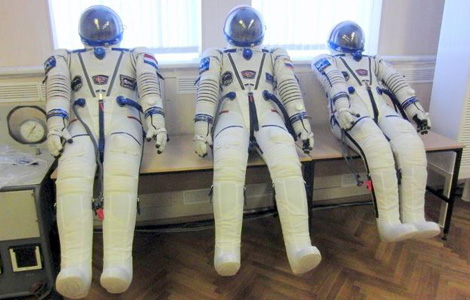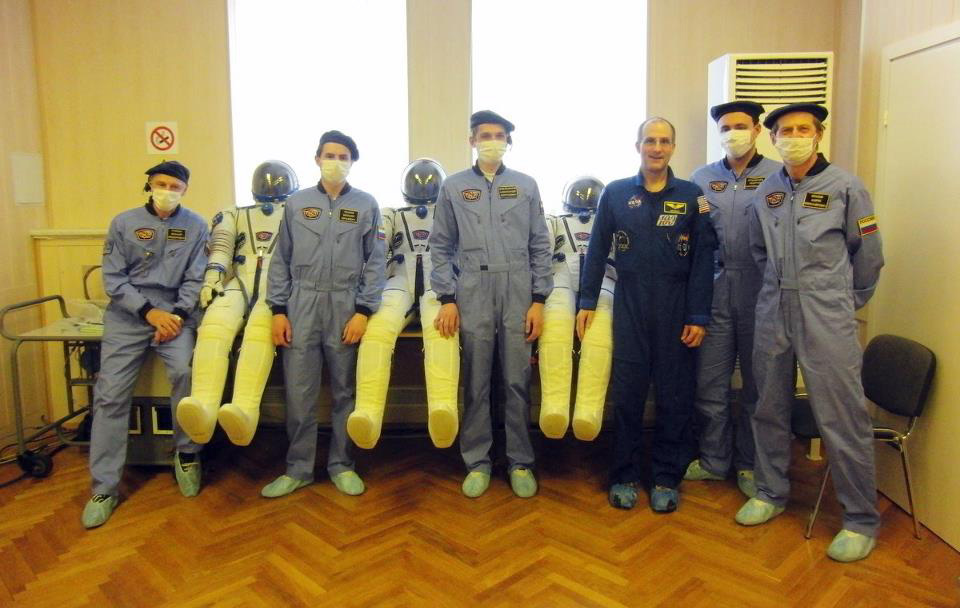Me and My Spacesuit
I have a symbiotic relationship with my spacesuit. I take care of it, and it takes care of me in return
Our Soyuz spacesuit is named after the Russian word for falcon: сокол (sokol). It serves only one purpose, to keep us alive in the event of a cockpit depressurization. We venture into a place that is devoid of nearly all matter–a vacuum. This vacuum is as vast as space itself, and in a flash will remove our life-sustaining vapors with no more perturbation than an 18-wheeler smashing a jackrabbit on Route 66. And the effect on your body would be about the same.
I have a symbiotic relationship with my spacesuit. I take care of it, and it takes care of me in return. Almost like a living exoskeleton, it can take on its own cantankerous personality, and will bite, pinch, and torque my flesh, leaving red pockmarks, bruises, pulled muscles, aching backs, screaming knees, and occasionally a bleeding scratch or a black fingernail (that slowly sloughs off like flesh in a sci-fi movie). Like taming a wild animal, I’m aware of its nature, and I put up with an occasional bite for the sheer pleasure of its company.
By design a space suit is hermetically sealed, so it creates a microclimate that rapidly reaches 100% humidity at body temperatures. We do have cooling—a rather slow flow of air at tepid temperatures that sweeps out some of the steamy vapor. If you just sit there, this cooling is adequate. We do have periods, particularly during emergencies, where we become quite active. During our training for fires (simulated with stage smoke), cockpit depressurization (simulated by inflating our suits), and ocean landings (we practice the real thing in the Black Sea), the cooling system is deactivated and temperatures rise. During some of these exercises, core body temperatures have reached over 39° C (102° F), requiring intervention from the array of flight surgeons who monitor the exercise. During such exercises I have produced over 2 kilograms (4½ pounds) of sweat, which ends up inside my sealed spacesuit. The suit thus becomes a mobile, living sauna. No wonder crews practice the Russian tradition of sauna for off-duty relaxation—it’s training for the real thing.
My spacesuit is a marvel of fabric, polymers, and metal, custom-fit to my particular anatomy. It becomes a spacecraft in itself, shrunken down to conform to the shape of my body. It is imperative to understand not only where all the various levers, knobs, and closures are located, but also the engineering behind their operation. Every spacesuit has a regulator that senses the inside pressure so that it doesn’t drop below a level required to maintain consciousness. NASA spacesuits use a regulator based on the difference in pressure between inside the suit and outside. Russian suits use a regulator based on absolute pressure. To a first order, this design is transparent to the user; the spacesuits simply inflate when the ambient pressure drops. However, there are nuances that the user should keep in mind. Knowing the strengths and weaknesses of your pressure regulator will help you survive on a bad day.
When dealing with technology in this wilderness, especially when it’s required to keep one’s pink flesh safe, bad days can happen. Beware of claims for unsinkable ships. There were times when the U.S. and Russian space agencies both dispensed with spacesuits. They were deemed an unnecessary expense. The engineering guaranteed that cockpit depressurization could not happen. After both the U.S. and Russian programs lost full crews, due in part to spacecraft depressurization, the spacesuits were brought back. Another lesson learned, pried from the bodies of those who explore.
When it comes time to doff my suit, I strip it off with a mix of reverence (thank you for being there) and loathing (I can’t wait to get out of this thing). Like a moist, slimy worm emerging from a chrysalis, I shed this exoskeleton with great anticipation. Hot, sweat-soaked long underwear steams in the cool air, and gives me needed relief from evaporative cooling. This sensation is difficult to describe in words.
But our work is not done; we have to take care of our spacesuits. I hook mine up to a ventilator, which inflates it like a large blowup doll—or, more fitting, a blowup astronaut. It’s like we have visiting guests, perhaps company for dinner. It takes about 2½ hours to dry a suit. I do not want the inside of the suit to become a biological experiment.
Thus I dote over my spacesuit with the same care a knight might take in preparing his battle armor. While still on Earth, I have an array of suit technicians, modern day squires, to help in the process. These people are experts, there to teach you the proper way to care for your spacesuit, for there will come a day when you are on your own and have to operate without any help. If you want to increase your chances to survive, it is imperative to absorb their pearls and become one with your suit.
I hate my spacesuit; I love my spacesuit. Such contradictory thoughts remind me that I am very much alive.

